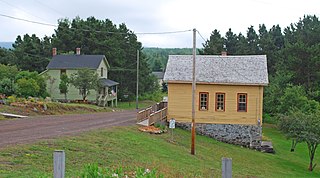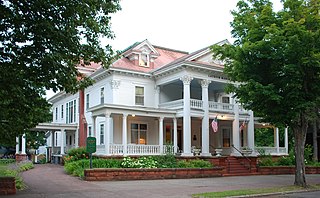The following is a list of Registered Historic Places in Iron County, Michigan. The list includes 79 structures and historic districts that are significant for their architectural, historical, or industrial/economic importance.

This is a list of the National Register of Historic Places listings in Houghton County, Michigan.

The Calumet Historic District is a National Historic Landmark District that encompasses most of the village of Calumet, Michigan. The district was designated in 1989 for the community's importance in the history of the region's copper mining industry.

The Church of the Assumption is an historic Carpenter Gothic style Roman Catholic church located on US 41, 400 feet east of M-26 in Phoenix in Houghton Township, Michigan. It is also known as the Phoenix Church. The church was listed on the National Register of Historic Places in 2000.

The Central Mine Historic District is a historic district located off US 41 in Upper Michigan. The mine itself was designated a Michigan State Historic Site in 1958, while the surrounding district was designated a Michigan State Historic Site in 1973 and listed on the National Register of Historic Places in 1974.

The Thomas H. Hoatson House is a house located at 320 Tamarack Street in Laurium, Michigan. It was listed on the National Register of Historic Places in 1994. At 13,000 square feet (1,200 m2), it is the largest mansion in the western Upper Peninsula of Michigan.

The Calumet and Hecla Industrial District is a historic district located in Calumet, Michigan and roughly bounded by Hecla & Torch Lake Railroad tracks, Calumet Avenue, Mine and Depot Streets. The district contains structures associated with the copper mines worked by the Calumet and Hecla Mining Company, located along a line above the copper lode, where railroad tracks connected separate mine heads. The Historic District is completely contained in the Calumet Historic District and the Keweenaw National Historical Park. It was designated a Michigan State Historic Site in 1973 and was listed on the National Register of Historic Places in 1974.

The Smith–Dengler House is a private home located at 58555 US 41 in Wolverine, Calumet Charter Township, Michigan, United States. It was listed on the National Register of Historic Places in 2008.

The Quincy Mine No. 2 Shaft Hoist House is an industrial building located north of Hancock, Michigan along US Highway 41 within the Quincy Mining Company Historic District. The Hoist House contains the largest steam hoisting engine in the world, which sits on the largest reinforced concrete engine foundation ever poured. The shaft hoist house was designated a Michigan State Historic Site in 1969 and listed on the National Register of Historic Places in 1970.

The John Chambers House is an originally residential building located at 90 North State Street in St. Ignace, Michigan. The house is currently operated as the Colonial House Inn. It was listed on the National Register of Historic Places in 1982.

The Eagle Harbor Schoolhouse is a school located at the corner of Third and Center Streets in Eagle Harbor, Michigan, United States. It is significant as the location where Justus H. Rathbone was first inspired to write the ritual which was the basis of the Order of the Knights of Pythias. The schoolhouse was designated a Michigan State Historic Site in 1971 and listed on the National Register of Historic Places in 1972. It is also known as the Pythian Shrine and as the Rathbone School.

The Johns Hotel (20IR64) is a complex of buildings, of which but two remain, located near Washington Harbor, on Barnum Island, Isle Royale National Park, Michigan. It was listed on the National Register of Historic Places in 1997.

The Ransom B. Shelden House is a private house located at 1304 College Avenue in Houghton, Michigan. It is currently used as the Tau Kappa Epsilon (TKE) Fraternity House. The house was listed on the National Register of Historic Places in 1980.

The Houghton County Courthouse is a government building located at 401 E. Houghton Street in Houghton, Michigan. It was designated a Michigan State Historic Site in 1974 and placed on the National Register of Historic Places in 1975.

The College Club House and Gymnasium is an educational building located at 1416 College Avenue on the campus of Michigan Technological University in Houghton, Michigan. It is also known as R.O.T.C. Building. The building is the oldest existing building on Michigan Tech's campus, and it was placed on the National Register of Historic Places in 1980.

The Iron County MRA is a Multiple Resource Area addition to the National Register of Historic Places, which includes 72 separate structures and historic districts within Iron County, Michigan, United States of America. These properties were identified and placed on the Register in 1983, with the exception of one property that was placed on the Register in 1993.

The Alabaster Historic District is a 400-acre mining complex in Iosco County, Michigan, centered on an open pit gypsum mine. It is bounded by on the east by Lake Huron, on the north by Gypsum Road, on the south by Keystone Road, and on the west by Rempert Road, south of Tawas City, the county seat. This historic district, where mining started in 1862, was listed on the National Register of Historic Places in 1977. Gypsum produced here was used to manufacture the temporary buildings of the World's Columbian Exposition in Chicago in 1893. The Alabaster Mining Company is still operating here.

The Frank J. Cobbs House is a private house located at 407 E. Chapin Street in Cadillac, Michigan. It was designated a Michigan State Historic Site in 1985 and listed on the National Register of Historic Places in 1988.

The Radka–Bradley House also known as the Bradley House, was built as a private house at 176 West Michigan Avenue in Rogers City, Michigan. It was listed on the National Register of Historic Places in 1991, and is now the Presque Isle County Historical Museum.

The Charles Mears Silver Lake Boardinghouse is a boardinghouse located at the outlet of Silver Lake, near Mears, Michigan. It is one of the few remaining structures built to serve the lumbering industry, which was Michigan's predominant industry in the 19th century. It was designated a Michigan State Historic Site and listed on the National Register of Historic Places in 1986.

























